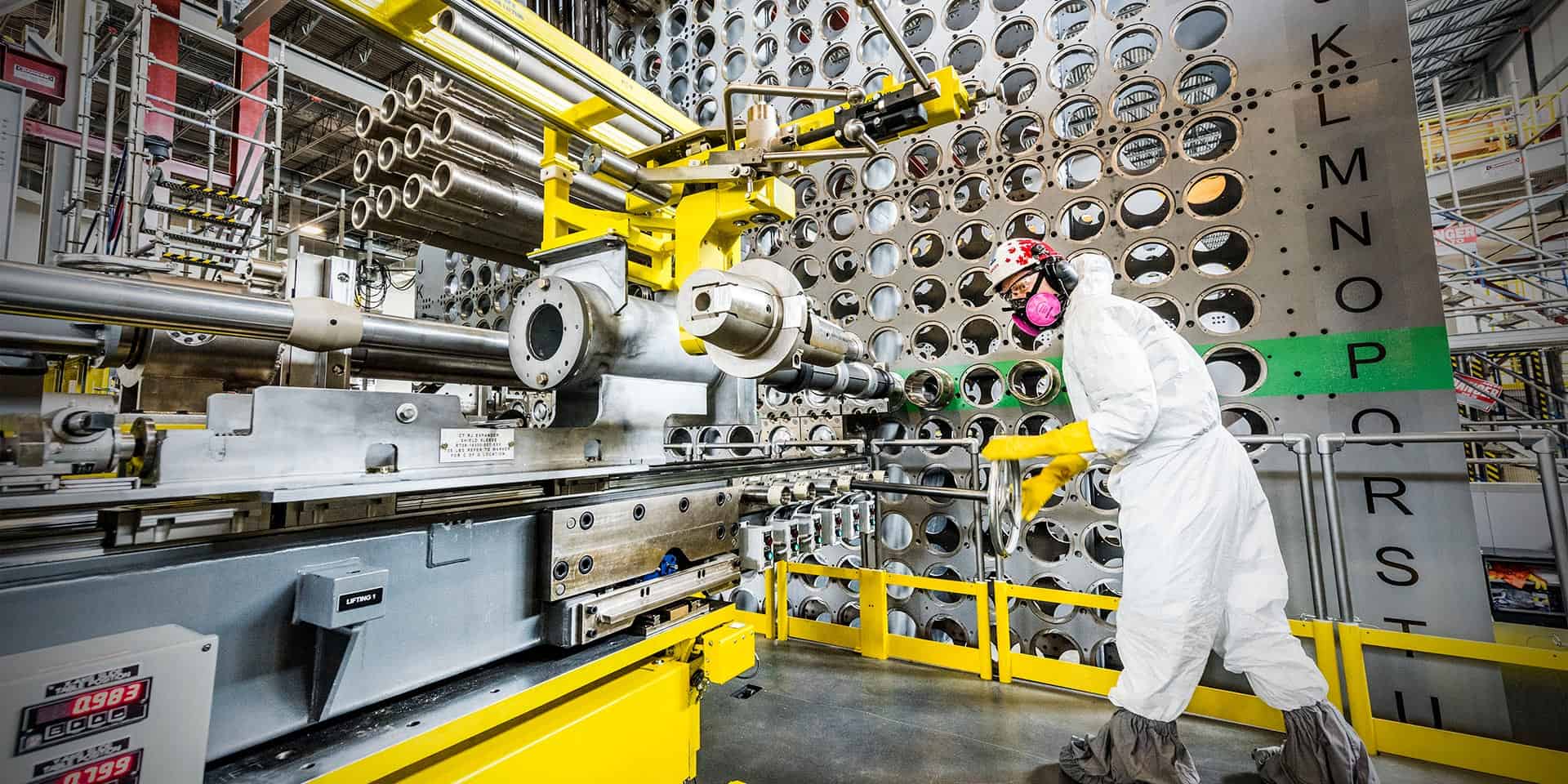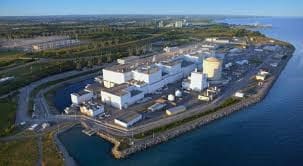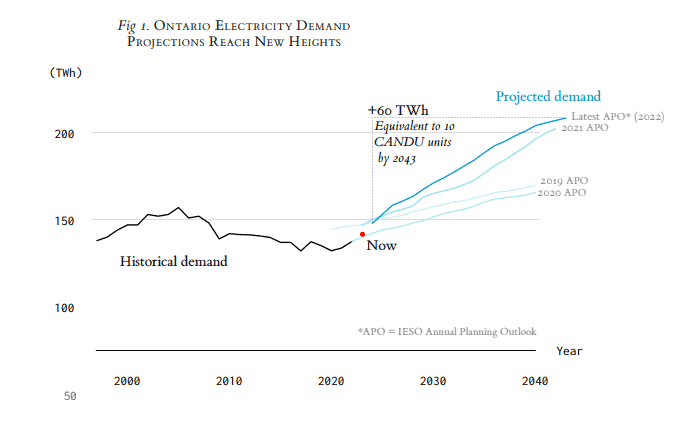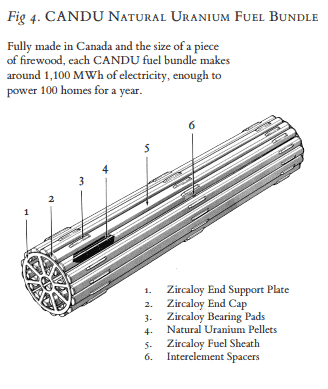Ten new nuclear reactors needed, starting with new build at Bowmanville’s Darlington site, declares report
Published May 17, 2023 at 8:23 am

A ramped up nuclear program using Canadian CANDU technology is the only way Ontario can meet its net zero commitments and the quickest route to that goal, declares a nuclear advocacy group in a 34-page manifesto released today, is through at least ten new reactors, starting with a new build at the Darlington nuclear station.
The report – The Case for CANDU – believes new CANDU reactors will be “absolutely neccessary” to meet surging electricity demand in Ontario.
The 300-megawatt small module reactor (SMR) build now underway at Darlington Nuclear Station near Bowmanville is a “great first step” but Canadians for Nuclear Energy, a grassroots nuclear advocacy group composed of energy workers, engineers, doctors, tradespeople, scientists, policy experts, and citizens, believe the logical next move is a CANDU new build at the Darlington site, where an existing license would speed up timelines by nearly a decade.
“CANDU new build is absolutely necessary. Refurbishments maintain but do not expand our ultra low carbon grid (and) we need more than just maintenance,” said the group’s president, Dr. Chris Keefer. “We need more electricity to meet a growing population, a restored manufacturing base and electrification.”

Darlington Nuclear Generating Station
The group is calling for the federal and provincial governments to develop and execute an “inclusive plan” for new CANDU alongside the BWRX-300 SMR being constructed at Darlington, as well as site development to support up to 10 new CANDU reactors, a “no regret action” that should begin “promptly.”
With climate goals now top of mind in Ottawa and at Queen’s Park, Keefer said the new electricity for the grid must be nuclear as other energy choices are “limited” in Ontario, leaving nuclear as the only other source of carbon free and “reliable” energy option.
The ‘Case for CANDU’ report notes that the makeup of the electric grid has changed in recent decades with the coal phaseout (made possible by the restart of existing reactors at the Bruce and Pickering nuclear plants) and new wind and solar capacity now on board, though intermittency limits their reliability. As well, hydroelectricity has been largely tapped out and nuclear refurbishments only preserve, rather than build, capacity.
Imports from Quebec have also been touted as a solution to Ontario’s energy needs but the idea of leaning on Ontario’s neighbour “could not withstand scrutiny” as Quebec has tightened exports to focus on its own energy goals.
That leaves natural gas and nuclear energy, the report declared, but natural gas – Ontario’s traditional default course – scores low on energy security, fuel independence, and carbon emissions and is the most price volatile of all energy sources, with dire consequences for businesses across Europe.

“Embracing nuclear energy is not a ‘lesser of evils’ decision. It is a strong energy option in its own right, as governments and expert bodies around the world – including the U.S. – are explicitly recognizing,” the report stated.
With huge energy-drawing factories like the electric arc furnaces needed for the steel industry and the Volkswagen battery plant coming to St. Thomas – each capable of a baseload draw on the grid equal to an SMR – the case for new nuclear to meet future demand is even stronger, Keefer said.
The timing of the report is no coincidence, he noted, with a “new appetite” for nuclear power, especially at the federal level where support for nuclear was lukewarm at best until very recently.
But Prime Minister Justin Trudeau has become a believer – thanks in large part to Keefer and his organization’s lobbying efforts – and Finance Minister Chrystia Freeland had plenty of praise for the nuclear industry at a visit to the Pickering nuclear plant last month, saying nuclear energy will help make Canada an “energy super power.”
Even Environment Minister Stephen Guilbeault, a former environmental activist and nuclear opponent, has now acknowledged that including clean, nuclear energy in the mix is the only way to keep global warming at bay.
In its 2023 budget, Ottawa also extended funding and tax incentives to large nuclear projects, something it had previously left out and the provincial energy ministry has put nuclear development beyond the Darlington SMR project on the table as well.

Dr. Chris Keefer and Prime Minister Justin Trudeau
“There is a new-found appetite for nuclear in general (but) that interest has been limited to SMRs only over the last decade because there hasn’t been the forecasted electricity demand to justify the upfront investment for large reactors,” Keefer pointed out. “But projections are becoming increasingly more firm on the growing future needs of the province and so large nuclear is back on the table.”
Ontario’s Independent Electricity System Operators (IESO) said Ontario’s electricity demand is rising and predicts demand equivalent to ten new CANDU reactors, in addition to the current fleet of 18, by 2043. By 2050 that number shoots even higher, with a need for nearly 18,000 megawatts of new nuclear required to reach net zero, or an additional 15 CANDU reactors for a total of 25 —a rate of construction not achieved since the CANDU buildout from the 1960s to the 1990s. New capacity must also overcome the lost output from expiring contracts and facilities over the next two decades, which make one-fifth of the province’s electricity from solar, wind, and natural gas, the report noted.
‘The Case for CANDU,’ the product of six months of work mobilizing dozens of experts to conduct research and data analysis, documents the three most important reasons why new nuclear – and especially CANDU technology reactors – are crucial to provincial and federal future energy needs and climate goals:
-
Coming electricity shortfalls have firmed up ambition for new nuclear capacity
-
CANDU, a homegrown reactor technology, is far ahead of other options in terms of local economic benefit, fuel security and project risk mitigation and has a proven track record of success
-
A window of opportunity created by ongoing CANDU refurbishments offers a smooth onramp to new builds
Canada, and especially Ontario, is poised for rapid growth in electricity use without the supply to meet it and there will be capacity shortfalls without new nuclear power, the report stated, with ‘brownouts’ on the horizon if Canada does not rapidly add capacity to the grid. “As policymakers search for solutions, a sober concern for energy security, fuel and technology independence, affordability, and emissions limits the available options. In this context, attention has again turned to nuclear energy as a proven way to meet clean electricity needs without sacrificing affordability or the stability of the grid.”
“We argue that CANDU is the lowest-risk, highest-benefit of Canada’s large nuclear options.”
Besides the already approved license at Darlington, the CANDU reputation for reliability and OPG’s recent track record of delivering nuclear refurbishments on time and on budget are further evidence of the need to build new CANDU nuclear in Ontario, Keefer said, citing Darlington’s $12.8 billion refurbishment program as an example.

Ontario is also home to the only manufacturer of large nuclear components left in North America and has a huge supply chain, with hundreds of companies involved in the sector in the GTA alone, including 34 in Mississauga, 16 in Burlington, 15 in Oshawa, 14 in Niagara Region, 11 in Whitby and 10 each in Pickering, Clarington and Oakville.
Not everyone is board the nuclear express, it should be noted, with anti-nuclear activists and a cross-partisan group of MPs urging the federal government last month to drop its support for nuclear energy projects, calling the energy source a “dirty, dangerous distraction” from climate action.
But ‘The Case for CANDU’ argues the naysayers are clinging to outdated information and declares the “window of opportunity” is now for building new nuclear. Letting that opportunity lapse with the end of the refurbishments, the report claimed, would be an “irreparable loss” to Ontario’s jobs, economy, and clean energy. “Building new CANDU would preserve and grow Ontario’s hard-earned legacy as a clean energy leader and signal its openness to business investment for the long-term.”
Keefer believes Ontario is well positioned to deliver new nuclear on time and on budget given the “remarkable success” of the CANDU refurbishments, which are massive mega projects closely related in scope to new build nuclear, adding that the projects should give Ottawa and Queen’s Park a “good deal of confidence” in the industry’s new build abilities.
“We have a reactor in waiting in the CANDU and a tried and tested and iteratively improved design with a supply chain, workforce and project management teams that are primed and ready to go,” Keefer pointed out. “The recent struggles in the U.S. and Europe with new build nuclear are precisely because of an atrophy of supply chains and a lack of skilled nuclear workers and mega project management skills. Ontario is the best equipped jurisdiction in the western world to lead a nuclear renaissance.”
It is “urgent,” he added, that new CANDU nuclear – a technology with a 96 per cent made-in-Ontario supply chain – is added to “minimize the amount of natural gas we will have to add to our mix in order to preserve system reliability.”

The refurbishment project at Darlington
With decades of affordable power, uninterrupted fuel supply, successful exports, local jobs, community benefit, and a track record of decarbonization, Canadians for Nuclear Energy believe CANDU technology will meet the strictest criteria for new supply once built and will continue to do so for generations.
The idea, the report declared, is for nuclear operators and the provincial Ministry of Energy to approach the federal government, once plans are in place, to discuss avenues of support, including funding for modernizations, heavy water production, and expedited licensing for new sites.
These are energy challenges for which Ontario has a “proven solution” and the “ideal conditions” to solve, Keefer said. “The pieces are in place. All that remains is to take the first step. To secure affordable energy for present and future generations, let’s seize the moment and build new CANDU nuclear now.”
To read the full report, visit The Case for CANDU
insauga's Editorial Standards and Policies advertising





